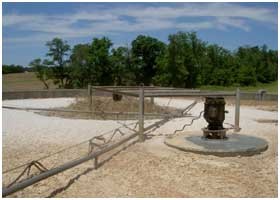Case Study | Filamentous & Foaming
Control in Biological Wastewater Treatment Plants
Activated Sludge
The most widely used wastewater treatment process is activated sludge biological treatment. The performance of these systems depends on the microbial biomass composition and behavior. Poor biomass settling and foaming occur when “undesirable” microorganisms are prevalent in the biomass. Increased populations of filamentous organisms are an example of this. Although they are typically part of all indigenous biomasses, the uncontrolled propagation of these stringy microbes can cause major problems in activated sludge plant operation.
Filamentous Microbes – Poor Settling/Foam
Filamentous organisms can be bacteria, fungi or algae whose cells have not detached following cell division
or have “stretched” but have not divided. Filaments containing such cells occur frequently. In domestic wastewater treatment plants, there are more than 30 species of filamentous organisms. In industrial wastewater treatment plants, the number of species may be several times higher depending on the nature of the water being treated. Most species are bacteria.

Causes/Impacts: The proliferation of filamentous organisms typically occurs in particular situations or because of several factors that occur either singly or in combinations:
- Extreme weather conditions
- Equipment or process configuration changes
- Influent character variability, biocides
- Process shutdowns/restarts
- Shock organic loads or variable flow rates
- Excessive fat, oil, and grease(FOG) in the influent
- Septic influent (sulfides and volatile fatty acids)
- Excessive sludge age/low Food to Mass (F/M) ratio
Common problems faced by activated sludge plants “invaded” by filamentous organisms include:
- Persistent foam formation
- Poor settling (high sludge blanket, high suspended solids in effluent)
- Increase in polymer/floc aid consumption
- Decline in biomass activity
- Poor sludge dewatering – increased costs of sludge management
- Inability to control sludge age
Step-wise Solutions
When filamentous bulking occurs, detailed analyses of the wastewater system influent and biomass should be performed. Microscopic analysis of the mixed liquor and foam, if present, is recommended to identify the filaments present and to observe any floc formation problems.
With a diagnosis of the cause(s) of the problem, an application program for microbial bioformulas is determined, along with a process operation regimen. Addition of the bioformulas along with proper process operating practices reduce the favorability of the conditions for filamentous organism proliferation by increasing competition for food with non-filamentous species and/or by destabilizing their stringy filamentous structure.
Case study Start Up & Control of Filamentous Organisms in a Pulp and Paper Treatment Plant
This case study describes the application and the effects of bioaugmentation used in a pulp and paper mill wastewater treatment plant, assisting in the start-up of the installation at commissioning and the control of filamentous development and foaming during operation over a three year period.
Case study Increased Domestic Wastewater Reuse by Filament Control via Bioaugmentation
This case study describes how bioaugmentation reduces filaments and foaming in a municipal wastewater treatment plant allowing more treated water to be re-used.